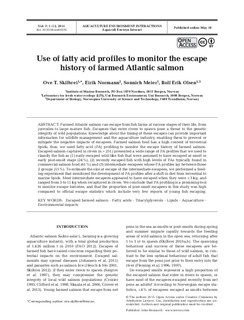| dc.contributor.author | Skilbrei, Ove Tommy | |
| dc.contributor.author | Normann, Eirik | |
| dc.contributor.author | Meier, Sonnich | |
| dc.contributor.author | Olsen, Rolf Erik | |
| dc.date.accessioned | 2015-06-15T12:34:15Z | |
| dc.date.accessioned | 2015-09-01T08:58:29Z | |
| dc.date.available | 2015-06-15T12:34:15Z | |
| dc.date.available | 2015-09-01T08:58:29Z | |
| dc.date.issued | 2015 | |
| dc.identifier.citation | Aquaculture Environment Interactions 2015, 7:1-13 | nb_NO |
| dc.identifier.issn | 1869-7534 | |
| dc.identifier.uri | http://hdl.handle.net/11250/298330 | |
| dc.description.abstract | Farmed Atlantic salmon can escape from fish farms at various stages of their life, from
juveniles to large mature fish. Escapees that enter rivers to spawn pose a threat to the genetic
integrity of wild populations. Knowledge about the timing of these escapes can provide important
information for wildlife management and the aquaculture industry, enabling them to prevent or
mitigate the negative impacts of escapees. Farmed salmon food has a high content of terrestrial
lipids; thus, we used fatty acid (FA) profiling to monitor the escape history of farmed salmon.
Escaped salmon captured in rivers (n = 251) presented a wide range of FA profiles that we used to
classify the fish as (1) early-escaped wild-like fish that were assumed to have escaped at smolt or
early post-smolt stage (24%), (2) recently escaped fish with high levels of FAs typically found in
commercial salmon food (61%) and (3) intermediate escapees whose FA profiles lay between those
2 groups (15%). To estimate the size at escape of the intermediate escapees, we performed a feeding
experiment that monitored the development of FA profiles after a shift in diet from terrestrial to
marine lipids. Most intermediate escapees appeared to have escaped when they were <3 kg, and
ranged from 3 to 11 kg when recaptured in rivers. We conclude that FA profiling is a promising tool
to monitor escape histories, and that the proportion of post-smolt escapees in this study was high
compared to official escape statistics which include very few reports of young fish escaping. | nb_NO |
| dc.language.iso | eng | nb_NO |
| dc.publisher | Inter-Research | nb_NO |
| dc.title | Use of fatty acid profiles to monitor the escapehistory of farmed Atlantic salmon | nb_NO |
| dc.type | Journal article | nb_NO |
| dc.type | Peer reviewed | en_GB |
| dc.date.updated | 2015-06-15T12:34:15Z | |
| dc.subject.nsi | VDP::Landbruks- og fiskerifag: 900::Fiskerifag: 920::Akvakultur: 922 | nb_NO |
| dc.subject.nsi | VDP::Agriculture and fisheries science: 900::Fisheries science: 920::Aquaculture: 922 | nb_NO |
| dc.subject.nsi | VDP::Matematikk og naturvitenskap: 400::Basale biofag: 470::Biokjemi: 476 | nb_NO |
| dc.subject.nsi | VDP::Mathematics and natural scienses: 400::Basic biosciences: 470::Biochemistry: 476 | nb_NO |
| dc.source.pagenumber | 1-13 | nb_NO |
| dc.source.volume | 7 | nb_NO |
| dc.source.journal | Aquaculture Environment Interactions | nb_NO |
| dc.identifier.doi | 10.3354/aei00132 | |
| dc.identifier.cristin | 1247445 | |
| dc.description.localcode | (C) Open Access under the Creative Commons by Attribution Licence (CC-BY). | nb_NO |
